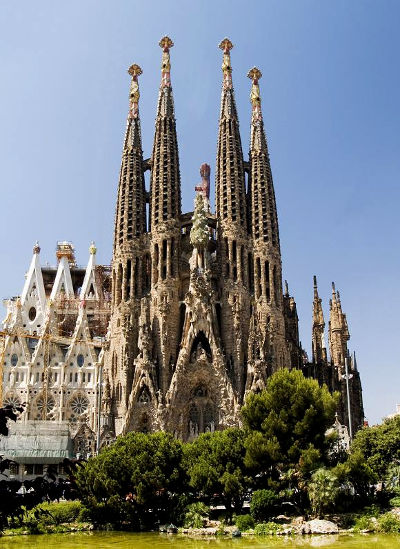 The Sagrada Familia, or Basilica of the Holy Family, in Barcelona, Spain, in 2010. (View of the Nativity facade, facing the east.) When Gaudi died in 1926, less than a quarter of the project was complete, with only one tower built. Construction passed the mid-point in 2010 with eight spires completed. The completion is anticipated for 2026 — the centennial of Gaudí’s death, with 18 spires. The Sagrada Familia, or Basilica of the Holy Family, in Barcelona, Spain, in 2010. (View of the Nativity facade, facing the east.) When Gaudi died in 1926, less than a quarter of the project was complete, with only one tower built. Construction passed the mid-point in 2010 with eight spires completed. The completion is anticipated for 2026 — the centennial of Gaudí’s death, with 18 spires. |
by Dom Antoine Marie, O.S.B.
“A church is the only thing worthy of representing the soul of a people, for religion is the most noble aspect of man,” according to Antoni Gaudi, the architect of the Basilica of the Holy Family in Barcelona, Spain. During its dedication on November 7, 2010, Pope Benedict XVI remarked, “At a time when man claims to be able to live with his back turned towards God, as though he no longer had anything to say to Him, the consecration of this church of the Sagrada Familia is an event of great significance. Through his work, Gaudi shows us that God is the true measure of man; that the secret of true originality consists, as he himself said, in returning to the beginning, which is God. Gaudi, by opening his spirit to God, was capable of creating in this city a space of beauty, faith and hope which leads one to an encounter with He who is truth and beauty itself.”
Antoni Gaudi was born on June 25, 1852, in Reus, in the province of Tarragona, Spain, the fifth child of Francesc Gaudi Serra and Antonia Cornet Bertran. He would know the sadness of the premature death of all of his brothers and sisters. This succession of deaths most likely explains Gaudi’s serious temperament. On his father’s side, Antoine came from an old family of coppersmiths. Seeing copper being shaped at his father’s workshop gave young Antoni the habit of “thinking in three dimensions.” From childhood, Antoni suffered from rheumatism that would never leave him. This illness constrained him to remain for long periods in the solitude of a small property his family owned in Riudoms, outside Reus. There, his eyes captured the Mediterranean light and the purest images of rocks, plants, and animals; he would always admire nature as a wonderful teacher. At school, Antoni was not a particularly good student, but he received a solid religious formation from the Piarists, the order founded by Saint Joseph Calasanz.
During the 1868-69 school year, the young man moved to Barcelona to study at the Upper Technical School of Architecture. He paid for his studies by working for well-regarded engineers and architects. He also attended classes in philosophy, aesthetics, and history at the university, and was interested in the world of culture. In his eyes, art must seek its inspiration in the laws and models observed in nature, the work of the Creator, in which shine Truth and Beauty. This search for beauty became the sole aim of his life. He received his degree in architecture in 1878.
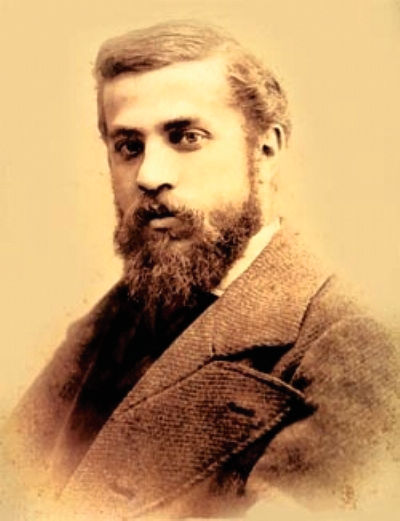 While he was working on the building of a co-op, he met a woman who taught the children of workers. The two spent long periods of time talking together. After wavering for a long time, Antoni finally spoke to her about becoming engaged, but the young woman confessed with regret that she already was. The young man then decided to dedicate himself body and soul to the Lord, as a celibate in the world. He cared for his father during his many years of old age, as well as for a sick and orphaned niece.
While he was working on the building of a co-op, he met a woman who taught the children of workers. The two spent long periods of time talking together. After wavering for a long time, Antoni finally spoke to her about becoming engaged, but the young woman confessed with regret that she already was. The young man then decided to dedicate himself body and soul to the Lord, as a celibate in the world. He cared for his father during his many years of old age, as well as for a sick and orphaned niece.
For the 1878 World’s Fair in Paris, Antoni devised an original window display for a manufacturer of luxury gloves. When the Count of Guell, a man of vast culture and one of the wealthiest individuals in Barcelona, learned that this masterpiece had been conceived in his city, he inquired about the identity of its creator. Thus was formed an indestructible friendship between the two men.
Immediately, the count commissioned the artist to design some pieces of furniture, then a number of buildings, including the extraordinary Park Guell. Antoni also became the close friend of Bishop Torras i Bages, the bishop of Vic, whose cause for beatification has been introduced, and the bishops of Majorca and Astorga, as well as a number of priests. Thanks to his friendship with these ecclesiastics, he gained a deep understanding of both the spirit of the liturgy and the social doctrine of the Church. From childhood, Gaudi was sensitive to the social problems of his era, particularly the living conditions of the working class. Early on, he realized that the profound social contradictions of his time could not find a solution in materialist utopias, but only by putting in practice Christian social doctrine.
Gaudi never wrote a book, although he left behind many notes on architecture and decor. Nevertheless, one could say that he was one of the best writers in history —not on paper but in stone. He never gave any lectures, but he frequently commented on his Sagrada Familia church to visitors, and he shared with his colleagues and disciples thoughts full of human and Christian wisdom. Passionate about aesthetics, he examined the enigma of beauty, and understood that it is because of Beauty (i.e., God Himself) that beautiful things are beautiful. He held that “beauty is the splendor of truth. Without truth, there is no art. Everyone is drawn to splendor — that is why art is universal.”
In his November 7, 2010 homily, Pope Benedict XVI observed, “Indeed, beauty is one of mankind’s greatest needs; it is the root from which the branches of our peace and the fruits of our hope come forth. Beauty also reveals God because, like Him, a work of beauty is pure gratuity; it calls us to freedom and draws us away from selfishness.”
The nineteenth century was, for Spain, a century of profound social upheavals. An anticlerical frenzy raged, and the Church was persecuted. Joseph Bocabella, a bookseller who had a great devotion to Saint Joseph, received the inspiration to build a church consecrated to the Holy Family of Nazareth. He wished to give a strong witness to the love of God and His Incarnate Son Jesus, in expiation for the sins of the men of his century. He started soliciting donations. As he began to raise funds, a great number of Christians joined in “to awaken lukewarm hearts that have fallen asleep, to increase Faith, and to rekindle Charity, so that the Lord might take pity on the country.” Construction began immediately, but soon a serious difference of opinion arose between Bocabella and his architect, and the architect abandoned the project. One night, Bocabella’s aunt had a dream — she saw the architect who would make the Holy Family rise from the ground. It was a young man with blue eyes. Attaching no importance to this dream, Joseph went to an architectural firm. Opening the door, he found himself face to face with a young man whose blue eyes gave him a start — for in fact, in Catalonia blue eyes are rare. This young architect was named Gaudi. Although Bocabella’s taste tended towards a strict classicism, he came round to Gaudi’s loftier ideas without hesitation.
Convinced that, without sacrifice, it was impossible to have the work succeed, Antoni Gaudi abandoned the easy life he had enjoyed as a young architect of great prestige. He intensified his prayer and adopted a rigorous asceticism. “This Temple is a temple of expiation,” he explained, “which means that is fed by sacrifices.” During Lent of 1894, he fasted so severely that he was brought to death’s door. His friend, Bishop Torras i Bages, had to intervene to persuade him to take some food. “Life is love and love is sacrifice,” Antoni would emphasize. “If a household shows vitality, it is because someone is sacrificing. It is sometimes a servant.” The great love of God and neighbor that filled Antoni had its roots in love for the Cross. In fact, Gaudi crowned his works, both secular and religious, with a four-armed Cross, which often bore the acronym for the Holy Family: “JMJ” (Jesus, Mary, Joseph).
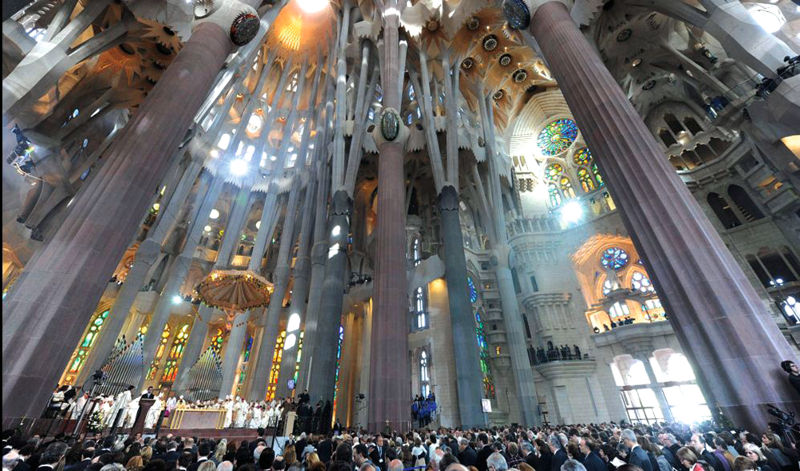 Interior of the Basilica, during the consecration by Pope Benedict XVI on November 7, 2010. Every column (there are 52 in all, for the 52 weeks of the year) is in the form of a tree, with its branches and foliage. Above the nave, colored pinnacles represent the fruits of the promised land, alternating with grapes and wheat, symbols of the Eucharist. In his homily, the Holy Father said: “The joy which I feel at presiding at this ceremony became all the greater when I learned that this shrine, since its beginnings, has had a special relationship with Saint Joseph. I have been moved above all by Gaudi’s confidence when, in the face of many difficulties, filled with trust in divine Providence, he would exclaim, ‘Saint Joseph will finish this church.’ So it is significant that it is also being dedicated by a Pope whose baptismal name is Joseph.” Interior of the Basilica, during the consecration by Pope Benedict XVI on November 7, 2010. Every column (there are 52 in all, for the 52 weeks of the year) is in the form of a tree, with its branches and foliage. Above the nave, colored pinnacles represent the fruits of the promised land, alternating with grapes and wheat, symbols of the Eucharist. In his homily, the Holy Father said: “The joy which I feel at presiding at this ceremony became all the greater when I learned that this shrine, since its beginnings, has had a special relationship with Saint Joseph. I have been moved above all by Gaudi’s confidence when, in the face of many difficulties, filled with trust in divine Providence, he would exclaim, ‘Saint Joseph will finish this church.’ So it is significant that it is also being dedicated by a Pope whose baptismal name is Joseph.” |
Gaudi designed the church of the Holy Family as a synthesis of Catholic doctrine. In it there would be represented the Creation of the world, the work of man on earth, the passage from the kingdom of darkness to the Kingdom of Light, the mysteries of the life of Christ, the seven Sacraments, the seven gifts of the Holy Spirit, the Beatitudes, death, Purgatory, Final Judgment, Hell, and Heaven. This “cathedral,” about 100 meters in length, would be built in the shape of a Latin cross, with five naves and three facades. The naves would be separated by slanting columns forming a parabolic arc. All the supports would converge towards the center to give stability to the building. Gaudi devised this innovative technique so that the eighteen towers he planned, about 110 meters tall, could withstand both strong winds and telluric movements. Gaudi’s work would be open to everyone: “The portal must be large enough,” he explained, “not for the individual man, but for all humanity, because all have a place in the heart of their Creator.”
“Gaudi,” observes Benedict XVI, “desired to unify that inspiration which came to him from the three books which nourished him as a man, as a believer and as an architect: the book of nature, the book of sacred Scripture and the book of the liturgy. In this way, he brought together the reality of the world and the history of salvation, as recounted in the Bible and made present in the liturgy. He made stones, trees and human life part of the church so that all creation might come together in praise of God, but at the same time he brought the sacred images outside so as to place before people the mystery of God revealed in the birth, passion, death and resurrection of Jesus Christ. In this way, he brilliantly helped to build our human consciousness, anchored in the world yet open to God, enlightened and sanctified by Christ.”
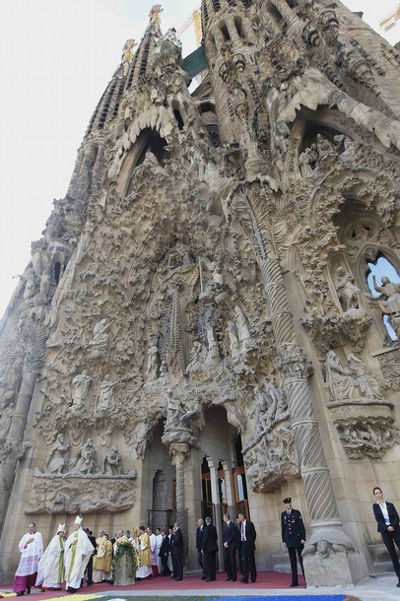 Details of the Nativity facade Details of the Nativity facade |
On the Holy Family’s enormous construction site, Gaudi established a wonderful feeling of brotherhood. Social security did not yet exist, and workers worked until the end of their lives. In his foresight, the architect established a system of mutual aid by which a small portion of each man’s salary was deducted to pay the salary of the worker who fell ill. The workers loved him so much that they called him “Father” when they spoke of him; Gaudi would never know of this. His kindness was proverbial. One day, a sculptor came to the construction site after a sleepless night. The architect told him, “When the body needs sleep, the first thing to do is to rest.” “Yes,” replied the sculptor, “I will do it when I get home.” “No,” answered Gaudi, “you must do it now.” And the sculptor had to obey. This father’s kindness was nevertheless combined with a very keen sense of justice. One of his clients did not want to pay him the fees he was due. Without hesitation, Gaudi took him to court; after winning the case, he gave the money to a convent. In cooperation with the parish priest, he designed and paid himself for a school to be built for the children of the bricklayers and of other poor families in the neighborhood. “The poor,” he would say, “must always find a welcome in the Church, which is an expression of Christian charity.”
But Gaudi sometimes had bouts of bad temper that were expressed in biting words. “With the temperament that I have,” he declared, “I have no choice but to say things as I see them. Of course, this hurts people.” He added, “My strength of will has enabled me to overcome all obstacles, except for one thing — improving my temperament.” It did not keep him, however, from being joyful and loving jokes.
One day, during a visit to the hospital, Gaudi, accompanied by a sculptor, was introduced by a Sister to a poor dying man who had no family. The two men stayed beside the ill man, whispering prayers in his ear until he very peaceably breathed his last. “This dying man’s devotion,” the architect would say, “made me think that the Holy Family was beside him. I had the idea of representing the scene in the cloister of the church.” On the spot, he created the sketch: the Child Jesus in the arms of His Mother leaning over, smiling, to caress the dying man, and Saint Joseph at the foot of the bed contemplating the scene.
Gaudi put everyone’s abilities to use. “Work is the fruit of collaboration, which can only be built on love. The architect must make use of all of the knowledge and ability of his colleagues. He must develop each man’s particular quality. He must integrate, adding up the efforts of all and supporting them when they begin to become discouraged. This is how one works with joy and the assurance that reflects the full confidence of the organizer. He must know that useless people do not exist. Everyone is useful according to his own abilities. One must simply discover each man’s abilities.” In his construction projects as well, Gaudi liked to integrate debris, scraps of metal, things that seemed useless. He also cultivated a love of work done well, and sought perfection: “Generally, when people do something, and the work is already good enough, they do not think of ways to improve it but are satisfied with the current result. This is a mistake. When work aims at perfection, one must make improvements until it is perfect.” He explained, from his personal experience, that the first try is seldom successful. Therefore, when people wanted to impose deadlines on him, he replied, “My client is not in a hurry.” In fact, he considered his only client to be the Lord Himself. Nevertheless, if he noticed a mistake in work done by one of his associates, he corrected it with great delicacy, saying, for example: “We did not understand each other well. We’ll try again.”
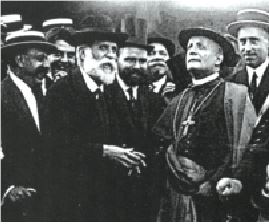 Gaudi (with the white beard) explaining his work to Cardinal Ragonesi of the Vatican in 1915. Gaudi (with the white beard) explaining his work to Cardinal Ragonesi of the Vatican in 1915. |
After his young niece’s premature death in 1912, fol- lowed by the death of his father, Gaudi remarked, “I no longer have anything. Now I can give myself completely to the church of the Holy Family.” He lived alone in his house in Park Guell, then in October 1925, he moved onto the Holy Family construction site. He dressed shabbily. His frugal diet consisted mainly of dried fruit and goat milk with lemon. He poured all his fees into the work of the basilica. When the economic crisis made itself felt, he began to beg to be able to pay his workers, a step which cost him greatly. One day a poor woman gave him a peseta, an infinitesimal sum, which he very happily placed in the church cash box. Another day, as he was waiting under a balcony sheltering himself from the rain, a passerby mistook him for a real beggar and gave him alms of two pesetas. They went the same path. Gaudi’s poverty led to some miscalculations. During the Infanta Isabella’s visit to the Holy Family, Gaudi appeared on the scene and the royal guards, seeing this man so poorly dressed, pushed him away. His coworkers exclaimed, “How stupid these guards are!” “No,” Gaudi replied, “they are doing their job.” He was sometimes mistaken for the sacristan, and he humbly gave the schedule of services. The ex-president of the Spanish Federal Republic, Francesc Pi i Margall, came one day to visit the Holy Family. He went down to the crypt, which was already being used for worship, and Gaudi politely offered him some holy water. Mr. Pi, an anticlerical, pretended not to see him, but Gaudi insisted, “Mr. Francesc, please“” And Pi i Margall surprised even himself as, in front of everyone, he made a lovely sign of the cross.
Another day, the rector of the University of Salamanca, Miguel de Unamuno, visited, a great writer who had become an anguished agnostic. Arriving before the facade of the Nativity, which proliferated with Christian symbols, he hurled at the architect: “You, a man so intelligent, you still believe in such things!” Gaudi did not react. A bit later, the Angelus rang. Gaudi broke off his conversation, removed his hat and, without fear of human respect, began to pray devoutly, after which, he said, “Praise God! I wish you all a good night!”
A visitor to the edifice, admiring this same facade adorned with a great abundance of images from nature, exclaimed, “It’s a song to Nature!” “Yes,” replied Gaudi, “but rather say ‘a song to Creation!” Gaudí was heavily criticized for the ornamentations in his work inspired by flora and fauna. He justified himself by pointing out that all these plants and animals were shown full of life and movement — created nature thus forming the court of its Creator.
Every day, Antoni attended Mass and immersed himself in reading the Gospel, from which he drew the inspiration for the figures which adorn the Holy Family. When he quoted the Gospel, everyone was impressed, even unbelievers. For him, “The man without religion is a mutilated man. To do things well, one must first have love, only then technique.” Passionate about Gregorian chant, he took a course at the Palace of Music in Barcelona. When asked the reason for his interest, he replied, “I come here to learn architecture!” The choirs of the Holy Family were designed to accommodate around 3,000 singers, for the architect was convinced that the future belonged to the Church. He knew that all the wisdom and efforts of man to draw nearer to God find their end in Christ. His architecture is a dazzling testimony to this conviction — echoes of other traditions and cultures are used, like the base that bears the Cross. When he guided visitors through the building’s construction site, his explanations constituted an excellent exposition of Christian doctrine. A number of people from different religions, notably Buddhism and Shintoism, were converted to Catholicism after contact with Gaudi or his work.
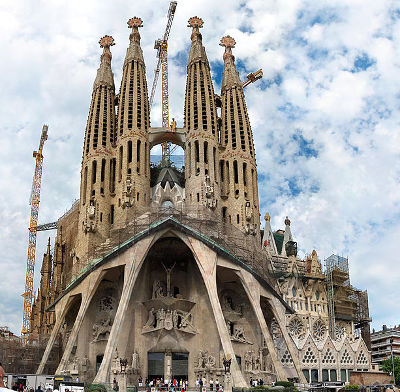 The Passion facade The Passion facade |
On the evening of June 7, 1926, about 6 pm, Gaudi was hit by a streetcar as he was leaving the construction site. Taken for a beggar, he was brought to the Hospital of the Holy Cross, run by nuns who served the poor. There he received Extreme Unction. When his true identity became known, the most expert medical teams offered their help, but it was too late. On June 10, Gaudi died, in poverty just as he had desired, after speaking these last words: “My God, my God!” His funeral was an occasion of great public mourning, where civil and ecclesiastic authorities rubbed shoulders with the most simple people. He was buried in the crypt of “his” church, in the chapel of Our Lady of Carmel. The process of his beatification is underway, and many graces have been received through his intercession.
Gaudi never believed he would finish the work himself: “I would not want to finish the construction of the church. That would not be fitting... Building the church is a prayer in time. We must leave to future generations the opportunity to praise God in its construction, and using other styles.” And he often said, “It is Saint Joseph who will finish this church.” In fact, the Holy Family, which Pope Benedict XVI has elevated to a minor basilica, is still unfinished.
During its dedication, the Pope pointed out a fundamental aspect of this work: “[Gaudi] accomplished one of the most important tasks of our times: overcoming the division between human consciousness and Christian consciousness, between living in this temporal world and being open to eternal life, between the beauty of things and God as beauty.” And he added, “We have dedicated this sacred space to God, who revealed and gave Himself to us in Christ so as to be definitively God among men... The Church of herself is nothing; she is called to be the sign and instrument of Christ, in pure docility to His authority and in total service to His mandate. The one Christ is the foundation of the one Church. He is the rock on which our faith is built. Building on this faith, let us strive together to show the world the face of God Who is love and the only One who can respond to our yearning for fulfillment. This is the great task before us: to show everyone that God is a God of peace not of violence, of freedom not of coercion, of harmony not of discord.”
May God make us all, according to our stations in life, artisans of beauty and of peace, witnesses to the Truth that is Christ, so that we may be called children of God!
Dom Antoine Marie, O.S.B.
This article is reprinted with permission from the Abbey of Clairval, France, which publishes every month a spiritual newsletter on the life of a saint, in English, French, Italian, or Dutch. Their postal address: Dom Antoine Marie, Abbe, Abbaye Saint-Joseph de Clairval 21150 Flavigny sur Ozerain, France. Their website: http://www.clairval.com
 In this special issue of the journal, MICHAEL, the reader will discover who are the true rulers of the world. We discuss that the current monetary system is a mechanism to control populations. The reader will come to understand that "crises" are created and that when governments attempt to get out of the grip of financial tyranny wars are waged.
In this special issue of the journal, MICHAEL, the reader will discover who are the true rulers of the world. We discuss that the current monetary system is a mechanism to control populations. The reader will come to understand that "crises" are created and that when governments attempt to get out of the grip of financial tyranny wars are waged.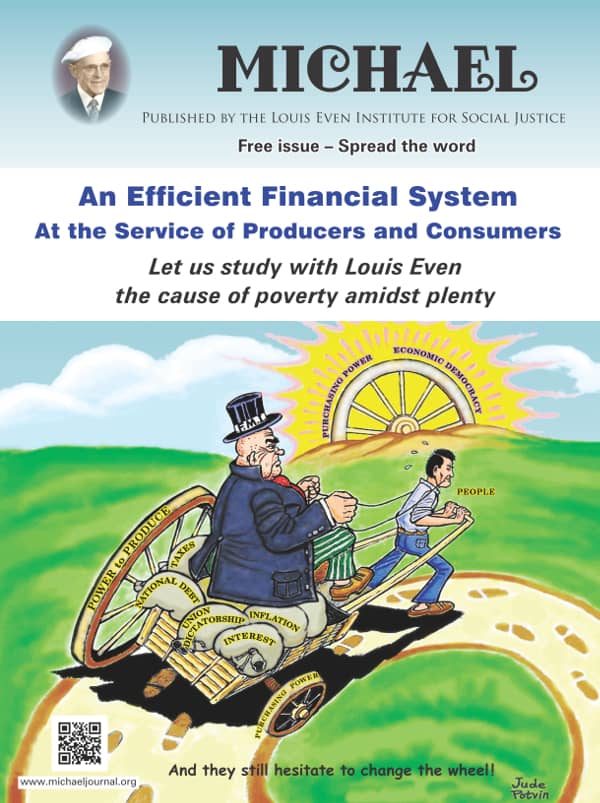 An Efficient Financial System, written by Louis Even, is for the reader who has some understanding of the Douglas Social Credit monetary reform principles. Technical aspects and applications are discussed in short chapters dedicated to the three propositions, how equilibrium between prices and purchasing power can be achieved, the financing of private and public production, how a Social Dividend would be financed, and, finally, what would become of taxes under a Douglas Social Credit economy. Study this publication to better grasp the practical application of Douglas' work.
An Efficient Financial System, written by Louis Even, is for the reader who has some understanding of the Douglas Social Credit monetary reform principles. Technical aspects and applications are discussed in short chapters dedicated to the three propositions, how equilibrium between prices and purchasing power can be achieved, the financing of private and public production, how a Social Dividend would be financed, and, finally, what would become of taxes under a Douglas Social Credit economy. Study this publication to better grasp the practical application of Douglas' work. 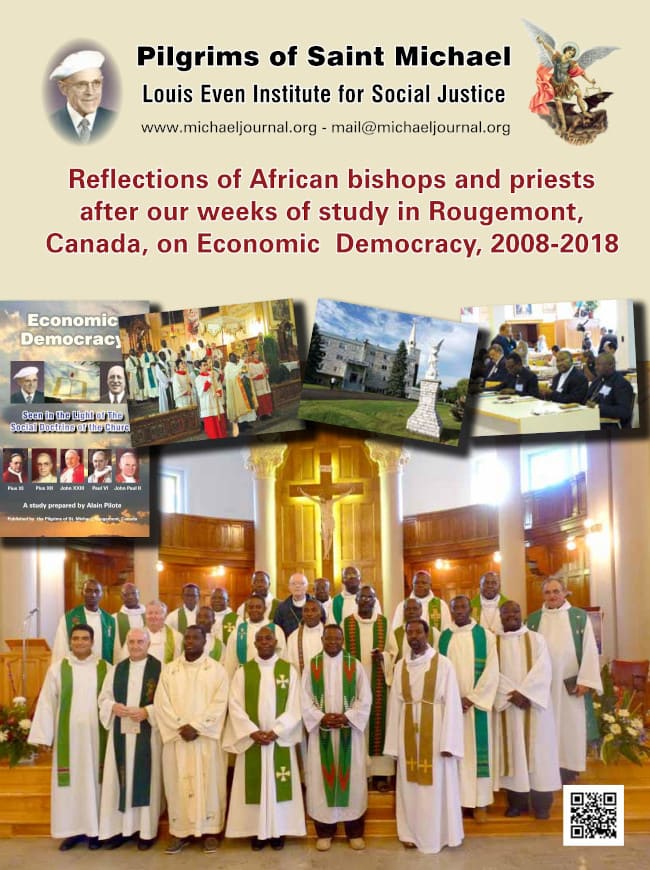 Reflections of African bishops and priests after our weeks of study in Rougemont, Canada, on Economic Democracy, 2008-2018
Reflections of African bishops and priests after our weeks of study in Rougemont, Canada, on Economic Democracy, 2008-2018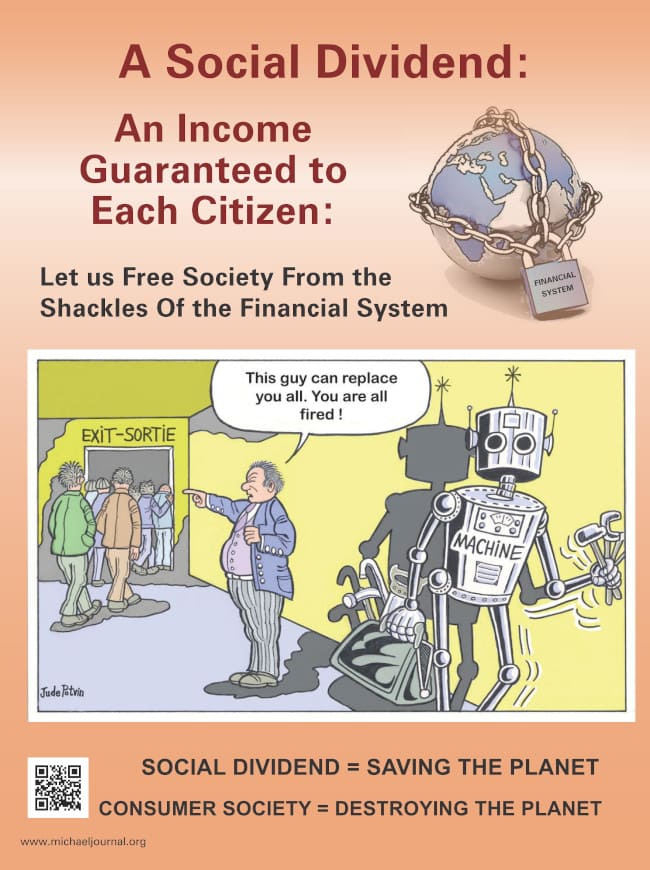 The Social Dividend is one of three principles that comprise the Social Credit monetary reform which is the topic of this booklet. The Social Dividend is an income granted to each citizen from cradle to grave, with- out condition, regardless of employment status.
The Social Dividend is one of three principles that comprise the Social Credit monetary reform which is the topic of this booklet. The Social Dividend is an income granted to each citizen from cradle to grave, with- out condition, regardless of employment status.Rougemont Quebec Monthly Meetings
Every 4th Sunday of every month, a monthly meeting is held in Rougemont.